What Is Okinawan Cuisine?
Okinawan cuisine refers to the unique food culture of Okinawa Prefecture in Japan.
Okinawa has a subtropical climate and a unique history and culture, which makes its food different from that of other parts of Japan.
The islands’ cuisine is typically characterized by its diversity of ingredients due to the climate, its heavy use of pork rooted in a culture where every part of a pig is used for food, and its use of marine products owing to the geographical feature of islands.
In addition, American food culture was introduced under the influence of U.S. governance after World War II.
Okinawan cuisine is often seasoned with awamori (Okinawa distilled spirit), brown sugar, and soy sauce, which add sweetness, savoriness, and a slight bitterness to its dishes.
Also, Okinawan soy sauce is slightly sweeter than soy sauce from mainland Japan.
Okinawan cuisine is deeply tied to the geographical and historical background of Okinawa.
From the 15th to the 19th century, Okinawa established its own culture as the Ryukyu Kingdom.
Trading with China, Southeast Asia, and Japan, Okinawa was introduced to a variety of food cultures.
After World War II, as a result of the U.S. administration, it adopted some of the American food culture, including SPAM (luncheon meat) and hamburgers.
The uniqueness of Okinawa's food culture is also represented in one of the region's customs of eating a steak after drinking alcohol ("Shime-steak"), which has drawn attention from other parts of Japan.
In recent years, Okinawan cuisine has become widely available in mainland Japan, including Tokyo, mainly through the spread of Okinawan restaurants.
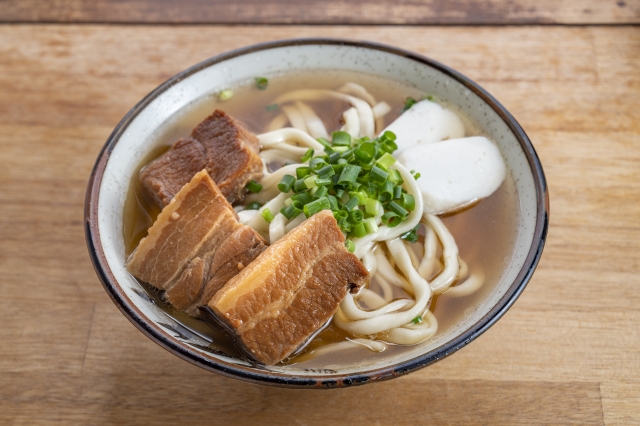
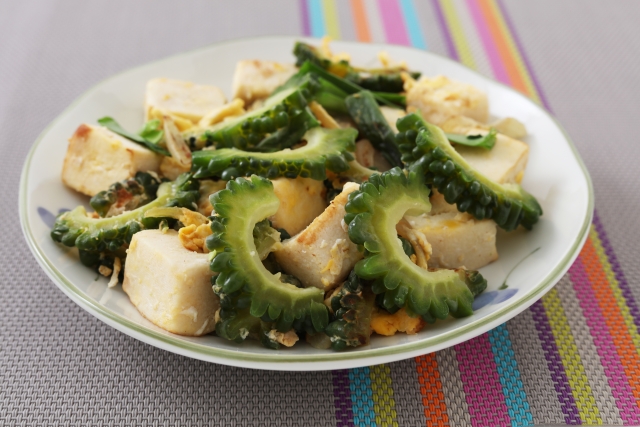
Varieties of Okinawan cuisine
In this entry, we will explore a variety of Okinawan cuisine.
Goya-Champuru (Stir-Fried Bitter Melon)
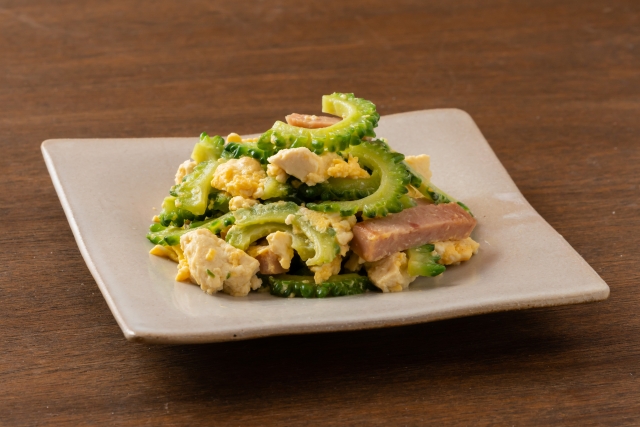
Goya (bitter melon) is the main ingredient in this dish, which is stir-fried with tofu, egg, bean sprouts, pork, and other ingredients.
The bitterness of goya creates a perfect match with the flavor of the other ingredients.
Simple condiments, such as soy sauce and salt, as well as koregusu (Okinawan chili sauce) may be added for a tangy, spicy flavor.
Rafute (Braised Pork Belly)
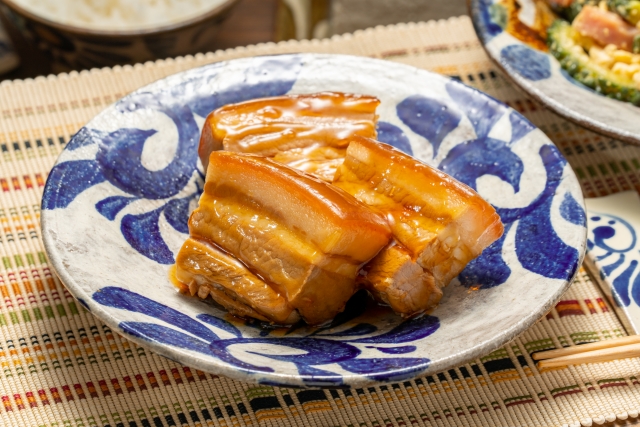
Pork belly is stewed and seasoned with soy sauce, sugar, and awamori (Okinawan distilled spirit) to add a sweet and spicy taste.
The meat becomes extremely tender by simmering for a long time.
Okinawa Soba (Thick-Noodle Soup)
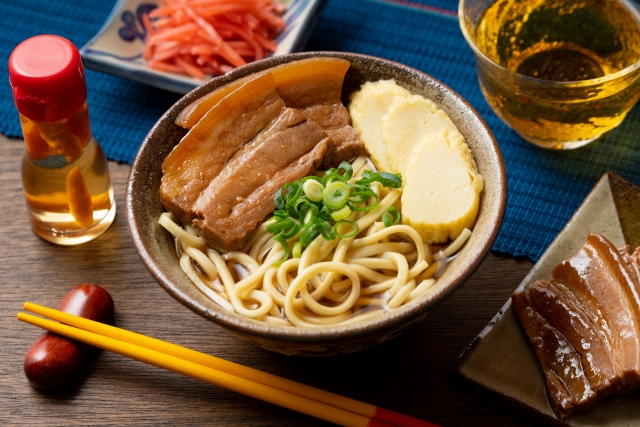
This unique noodle bowl from Okinawa consists of flat, slightly thick, wheat flour-based noodles served in a broth with toppings such as pork, fish paste, and green onions.
The broth varies from restaurant to restaurant.
It may be made from bonito stock, pork, or chicken bones and seasoned with soy sauce or salt.
Okinawa soba is topped with pork belly (“rafte” braised pork belly), but a bowl topped with soki (pork spare ribs) is called “soki soba.”
Mimiga (Boiled Pig Ear)
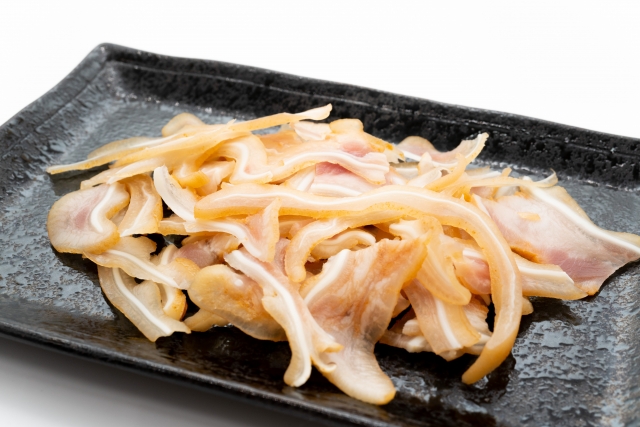
Mimiga refers to the skin part of a pig's ear.
It is characterized by its crunchy texture.
The delicious taste bursts in the mouth as you chew it.
Often used in salads, dressed foods, and stir-fries, it can be added as an accent to a variety of dishes.
Umi Budo (Green Algae or “Sea Grapes”)
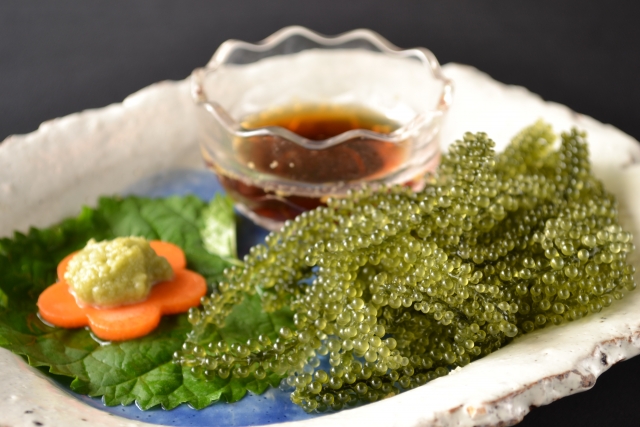
A type of seaweed found in Okinawa and other tropical seas.
It features a shape that resembles small grapes, as its name suggests.
The seaweed has long been a prized foodstuff in Okinawa and is still a popular specialty souvenir among tourists.
The greatest feature of umi budo is its unique texture when it pops in the mouth.
Umi budo itself does not have much taste, with only a faint hint of saltiness.
For this reason, ponzu (citrus soy sauce) or soy sauce-based dressings are often used for seasoning.
Ikasumi-jiru (Squid Ink Soup)
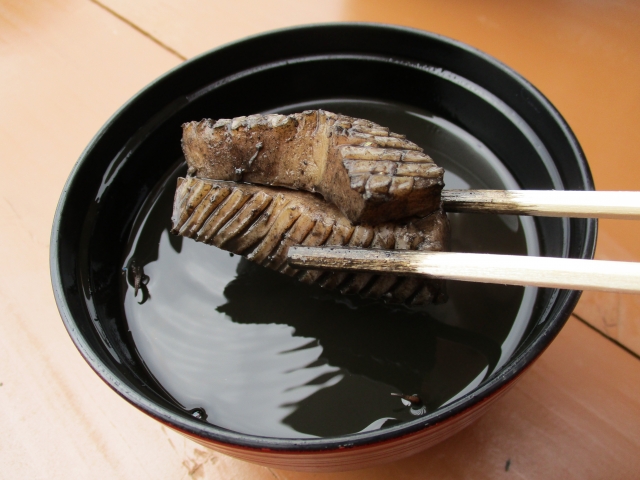
A local Okinawan soup dish made from squid ink.
It is characterized by the unique aroma and savory taste of the squid.
The soup is black due to the ink, giving it a distinctive appearance.
The ingredients typically include squid meat, pork, and vegetables.
Taco Rice (Rice Topped with Taco Fillings)
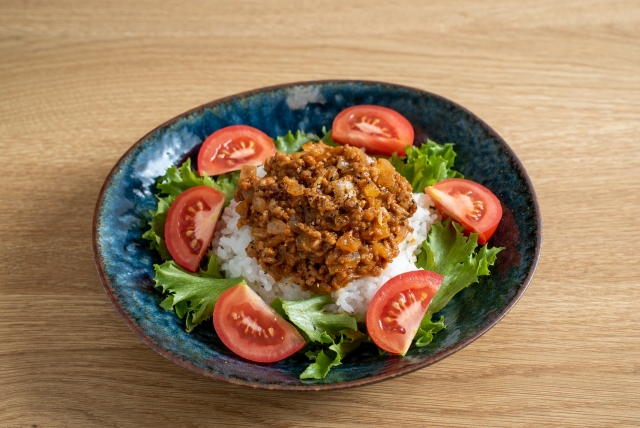
It consists of Mexican taco ingredients served on a bed of rice.
A typical taco rice dish consists of taco meat, lettuce, tomato, and other ingredients.
Depending on the restaurant, it may be served with cheese, fried egg, tortilla chips, or other toppings.
The dish is said to have originated in the 1980s when it was prepared for U.S. Marines in Okinawa.
Sata Andagi (Deep-Fried Donuts)
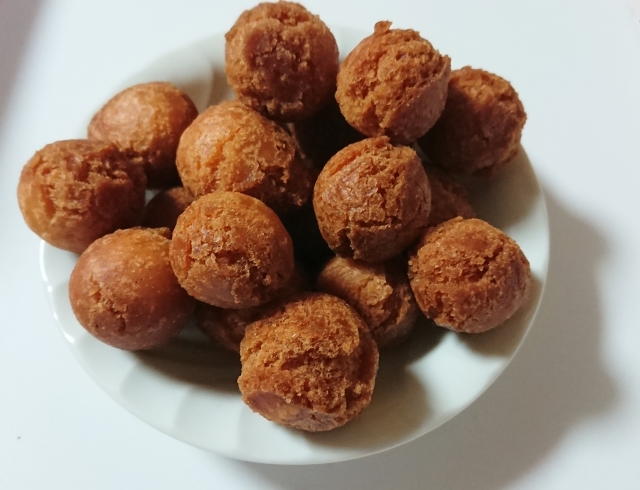
Sata andagi is a traditional Okinawan sweet, typically a small ball or irregular shape.
Characterized by its crispy outside and fluffy inside, the sweet is popular in Okinawa at festivals, events, and as a snack.
In the Okinawan dialect, "sata" refers to sugar and "andagi" refers to deep-fried.
In other words, sata andagi means “a sugared deep-fried sweet.”
Awamori (Okinawan Distilled Spirit)
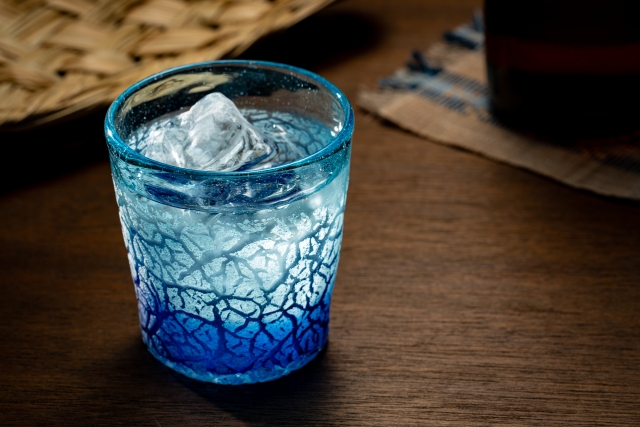
Awamori is a traditional distilled spirit produced in Okinawa.
It is made from Thai rice or long-grain rice and produced using a unique process.
Awamori is usually distilled once, has a high alcohol content (typical awamori is between 30% and 43% ABV), and features a clear taste.
Ingredients from Okinawa
Many of the Okinawan ingredients are rarely found in mainland Japan.
In this entry, we will explore some of the most common Okinawan ingredients.
Goya (Bitter Melon)
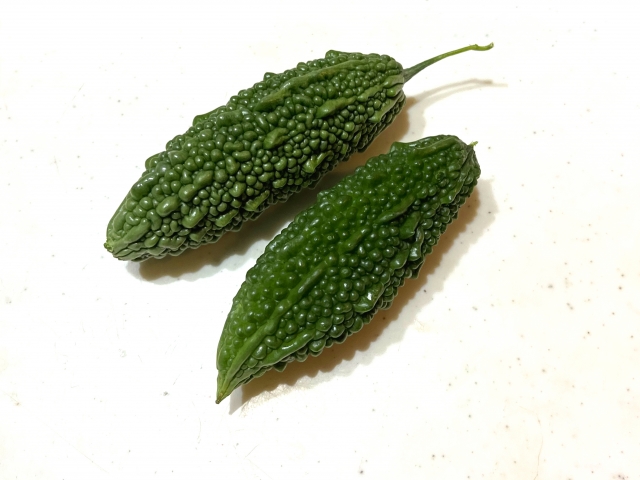
It belongs to the Cucurbitaceae family and is also called “nigauri” (bitter melon or gourd).
This green vine vegetable is marked by its knobby surface and unique bitter taste.
It is often eaten in goya-champuru (stir-fried bitter melon), salads, or pickles.
Agu Pork
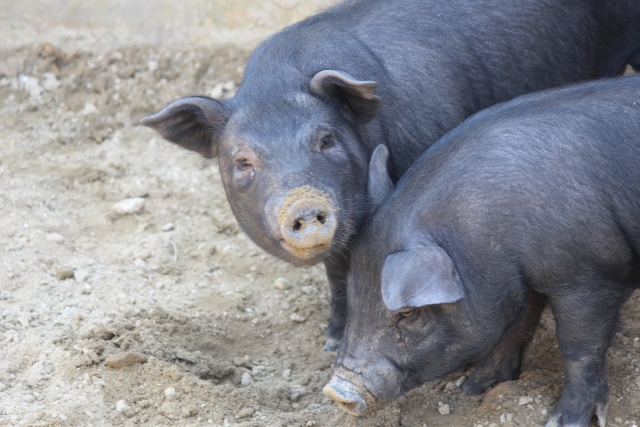
Agu is a well-known breed of pig raised in Okinawa (collectively known as Okinawan pigs).
Grown in the rich natural environment of Okinawa, the breed is known for its unique flavor and texture.
The meat of Agu pork is fatty and sweet.
It is used in various Okinawan dishes such as rafte (braised pork belly), soki soba (thick-noodle soup), and goya-champuru.
SPAM (Luncheon Meat)
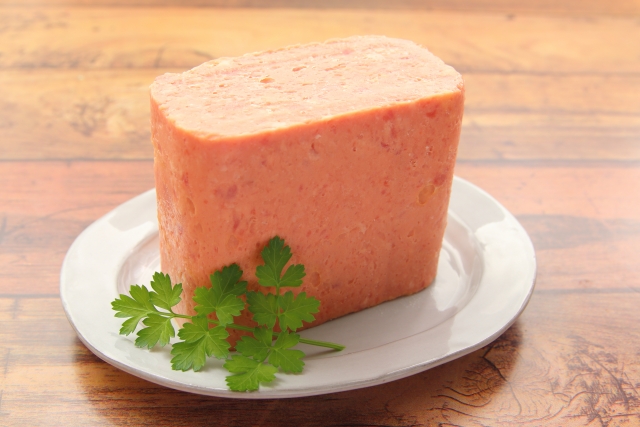
SPAM is a canned, processed meat product, primarily made from pork.
While SPAM is a trade name, the product refers to luncheon meat and is called “pork” in Okinawa.
SPAM was introduced in 1937 by Hormel Foods in the U.S. and was widely used as a preserved food for the armed forces during World War II.
Later, the product became a household name in Okinawa under the influence of the American governance period.
Today, SPAM is used in numerous dishes in Okinawan cuisine.
The meat is high in salt and fat and has a distinctive salty and savory taste.
Shikuwasa (Okinawan Lime)
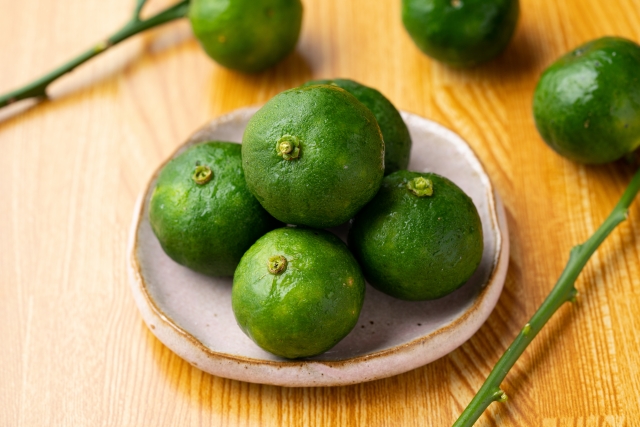
Shikuwasa is a type of citrus fruit.
Its small green or yellow fruits, 3 to 4 cm in diameter, are characterized by high acidity and a refreshing aroma.
Shikuwasa is a popular ingredient in sours and cocktails.
The fruit is also used to season seafood and meat dishes, effectively adding flavor to or removing odors from the ingredients.
Mozuku (Brown Seaweed)
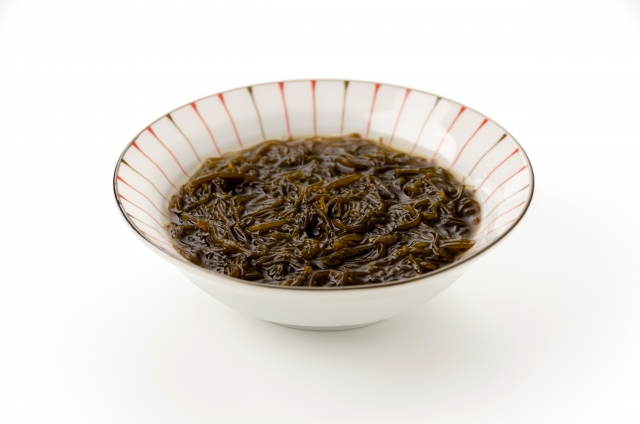
Mozuku is a variety of seaweed widely distributed in Japan and other Asian waters.
It is harvested abundantly in Okinawa and is an essential part of the local food culture of the islands.
Mozuku has a brownish-red, elongated or filamentous shape and is known for its slimy texture.
It is often eaten pickled in vinegar or used as an ingredient in miso soup, salads, and other dishes.
Mozuku is also highly nutritious, which giving it the attention of health-conscious people.
Shima-dofu (Okinawan-Style Tofu)
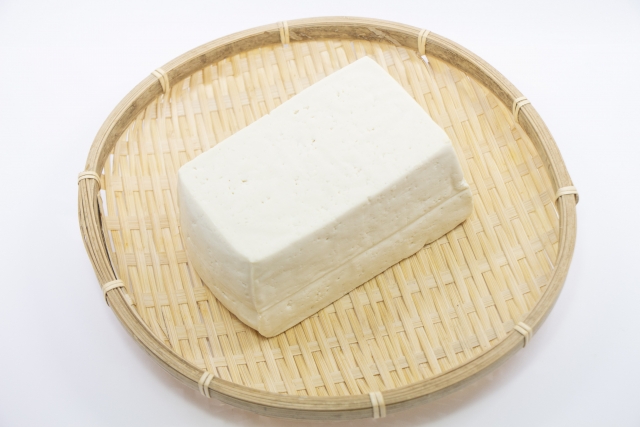
Shima-dofu is a type of tofu unique to Okinawa.
It is characterized by its lower water content and firmer texture than typical tofu in Japan.
It is used in dishes like goya-champuru and miso soup or eaten grilled.
One of the Shima-dofu varieties, “jimami tofu,” is a popular tofu in Okinawa made from squeezed peanut juice and is commonly eaten with a sweet sauce.
*Tofu is a food derived from soybeans.
It is made by soaking soybeans in water, crushing them, boiling and straining them, and adding a coagulant to the resulting soy milk to solidify it.
Widely consumed in Japan and other Asian countries, it is highly nutritious and used in a variety of dishes.
How to eat Okinawan cuisine
The following introduces how to eat some of the most popular Okinawan dishes.
Goya-Champuru (Stir-Fried Bitter Melon)
Enjoy it with chopsticks, a fork, or a spoon.
Rafute (Braised Pork Belly)
Enjoy it with chopsticks or a fork.
Recommended to be eaten as a side dish with rice or as a snack.
Okinawa Soba (Thick-Noodle Soup)
Mix noodles well with the other ingredients as you eat.
The aroma of broth and the texture of noodles are quite enjoyable.
If you have yakumi (garnish), put them on top of the bowl according to your preference.
Mimiga (Boiled Pig Ear)
This dish is usually seasoned with ponzu (citrus soy sauce) or soy sauce.
Enjoy it with chopsticks or a fork.
Relish its crunchy texture.
Umi Budo (Green Algae or “Sea Grapes”)
Umi budo itself does not have much flavor.
So enjoy it by dipping in ponzu or soy sauce served with it.
Enjoy the texture of it popping in your mouth.
Taco Rice (Rice Topped with Taco Fillings)
Mix all ingredients well to combine the flavors of the different ingredients for a lovely taste.
If you like spicy food, try adding some hot sauce or Tabasco.
Enjoy it with a spoon.
Sata Andagi (Deep-Fried Donuts)
Enjoy it as is.
If you have any toppings, eat them together with your sata andagi.
Awamori (Okinawan Distilled Spirit)
There are several ways to enjoy awamori.
Straight: Pour awamori directly into a glass and drink while enjoying the natural alcoholic flavor.
On the Rocks: Pour awamori into a glass filled with ice and drink it chilled.
Mizuwari (with water): Add cold or room temperature water to awamori to dilute it for a milder taste.
Oyuwari (with hot water): Add hot water to awamori to enjoy it warm.
It will mellow the flavor and warm up your body.
Cocktails: Mix awamori with fruit juices, sodas, syrups, etc., to create a cocktail.
What’s the Difference Between Okinawa Soba and Ramen? A Completely Different Dish Despite Their Similar Appearance
Many tourists visiting Okinawa may wonder, “How is Okinawa soba different from ramen?” At first glance, both are noodle dishes served in soup, and they do look similar. However, they differ significantly in terms of how the noodles are made, the flavor of the broth, and their cultural backgrounds.
To begin with, Okinawa soba is a traditional dish rooted in the food culture of the former Ryukyu Kingdom. On the other hand, ramen originated from Chinese noodle dishes and developed uniquely in Japan, with a completely different origin.
Let’s start with the noodles. Ramen noodles typically contain kansui, an alkaline solution that gives the noodles their yellow color and firm, chewy texture. In contrast, Okinawa soba noodles are made with wheat flour but usually without kansui, or with only a very small amount. As a result, they are more similar in appearance to udon and are known for their thick, flat shape and soft, springy texture.
The broth is another major point of difference. Ramen broths come in a wide variety and are often made from pork bones, chicken, or seafood. Okinawa soba, however, typically features a light and gentle flavor, made by blending pork bone broth with bonito flakes. In some cases, simple broths made from kombu (kelp) and salt are also used, allowing the natural flavors of the ingredients to stand out.
Toppings also reflect regional differences. While ramen commonly includes ingredients like sliced roast pork (chashu), soft-boiled eggs, and bamboo shoots, Okinawa soba is usually topped with rafute (braised pork belly), soki (pork spare ribs), fish cake, and green onions. Additionally, it is common to add koregusu, a local Okinawan condiment made by soaking chili peppers in awamori, according to personal preference.
As you can see, even though Okinawa soba and ramen may look alike, they are fundamentally different in terms of history, ingredients, and flavor. If you visit Okinawa, be sure to try Okinawa soba and enjoy its unique taste and cultural significance—distinct from that of ramen.



